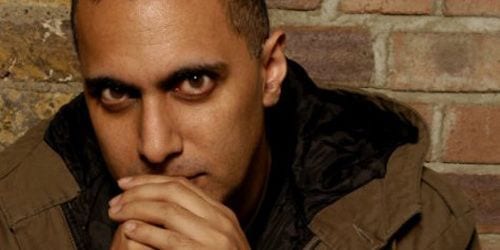
Nitin Sawhney’s eighth studio album, like much of his previous work, is a clearly defined Project. It comes with Sawhney’s usual accompanying conceptual comments, artwork by the British artist Antony Gormley, and a cast of guest contributors from new talent (Natty) to veteran rock royalty (Paul McCartney). The concept comes in the form of a set of reflections on everyday London life in the time following the July 2005 bombings. In Sawhney’s words, it is “a collection of thoughts, ideas, feelings and catharsis in a city of immense diversity, imagination and beliefs” that “attempts to capture a zeitgeist and common humanity that pervades superficial divides”. The central question of how one goes about fusing “diversity” with “commonality” is a problem that both guides and derails this project.
The album starts promisingly with “Days of Fire”, featuring vocals by Natty, the young London artist who released his debut album, Man Like I, in 2008. “Days of Fire” has a compelling vocal flow and an equally compelling narrative, depicting the shocked response to the July 7 bombings and to the subsequent fatal shooting by Metropolitan Police officers of the innocent Brazilian Jean Charles de Menezes. The acoustic guitar, laid-back groove, and mellifluous vocals typical of Natty’s work do not detract from the seriousness of the subject matter; rather, like the singer’s “The King Had A Dream” (available on Natty’s MySpace page), they manage to instill a sense of hope in the wake of atrocity.
From here, the album moves into blander territory both musically and lyrically. Tina Grace’s first contribution, “October Daze”, has a breathy intimacy that is pleasant enough but ultimately fails to engage at either a verbal or a dynamic level. “Bring It Home”, featuring Imogen Heap, drifts by for five minutes in a haze of vague, supposedly evocative lines (“anything’s possible / we’re in this together”) repeated rather too many times. The McCartney contribution delivers the line “life’s being run at a blistering pace”, but the tempo is plodding and generally lifeless. After three minutes the track is given an injection of excitement as the tempo picks up and the vocal gains some passion, but it is not enough to lift the song from the average.
Following this rather lifeless section, London Undersound improves with an eclectic group of pieces that play to Sawhney’s strength as a composer and to the skills of his collaborators. “Distant Dreams” is a catchy pop tune built on a dynamic instrumental palette and driven by a halting, insistent beat and the appealingly grainy voice of Roxanne Tataei. “Shadowland”, featuring the Spanish band Ojos de Brujo, is a piece of sonic fusion which mines Sawhney’s long term interest in the mixing of eastern and western sound textures. Featuring wordless vocals, beats and flamenco guitar and palmas (clapped percussion), it both extends Ojos de Brujo’s own hybridized flamenco project and reaffirms Sawhney’s commitment to the genre (he is an accomplished flamenco guitarist himself). “Shadowland” is followed by another wordless vocal performance, this time from the accomplished Pakistani singer Faheem Mazhar, entitled “Daybreak”. This piece is designed to showcase Mazhar’s rhythmic skill and consists initially of syllabic vocal exercises accompanied by simple plucked strings; these are later joined by percussion to act as a counterpoint to the vocal acrobatics.
Tina Grace’s second contribution, “Transmission”, is a much darker affair than “October Daze”, placing it in the territory of the murkier experiments of 1990s trip hop and the gentler end of dubstep. “Feel the sunshine from the radio / Sycophantic, laughing, manic”, Grace intones over the ominous bass and restless beat. Here, for once, an “undersound” — the sonic spatiality that would connect the faceless experience of urban travel with a noise that emanates from below the streets and seeps through the cracked pavements of the city’s non-spaces — seems finally to be realized.
London Undersound closes with two instrumental pieces that confirm the album’s overall mood as reflective. “Firmament”, inspired by a sculpture of the same name by Gormley, is a gentle work for guitar, flute, and cello. “Charu Keshi Rain”, which features the sitar playing of Anoushka Shankar, is based on the raag charukeshi performed by Shankar’s father Ravi, among other musicians. Abandoning tradition, Sawhney adds a piano accompaniment to the piece, effectively deterritorializing it from the discipline of its source material.
My overall impression of Sawhney’s album is of a lack of focus. The concept is strong, but it requires a lot of imagination on the part of the listener to understand how these quite disparate approaches to the subject matter are to be made coherent. Granted, reflection on the everyday will inevitably result in a myriad of feelings, responses, and representations. But some level of coherence is necessary for the catharsis Sawhney claims to desire. Effective representation of the everyday calls, paradoxically, for a sense of event. For an album that seeks to get underneath the city of London, this project feels too superficial. There is not the activist “nostalgia work” of writers such as Iain Sinclair, the sense of uncanny to be found in the dubstep pioneers, or the street-level response to urban terror in its many forms that could be found for a while in grime. Neither angry nor elegiac enough, what we have instead is a highly professional, too-slick response to the changed spaces of the city.

![Call for Papers: All Things Reconsidered [MUSIC] May-August 2024](https://www.popmatters.com/wp-content/uploads/2024/04/all-things-reconsidered-call-music-may-2024-720x380.jpg)



